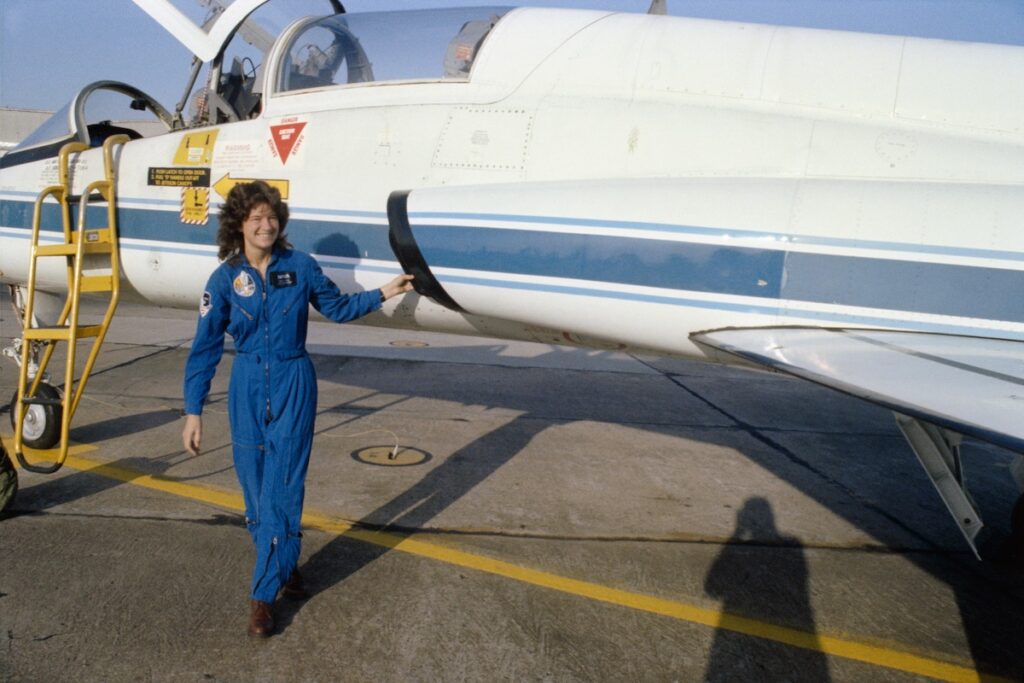Documentary on Astronaut Sally Ride Goes Well Beyond the Public Life of a National Hero
Despite being the most famous person on Earth for a while in 1983, when she flew on the space shuttle Challenger’s second mission, Ride was an intensely private individual.

The best biographies often explore the tensions between and intersections of their subjects’ public and private lives, and a documentary focused on a “public figure” is no different. “Sally,” the new film about America’s first female astronaut to fly in space, Sally Ride, largely hews to the standard approach, detailing her rise from ambitious youngster to interstellar heroine and respected luminary. What is surprising is how much the doc also delves into her personal life, particularly her relationship with a childhood friend turned life partner, Tam O’Shaughnessy, who is featured throughout the film and listed as one of its executive producers.
When Ride died in 2012 from pancreatic cancer, news reports disclosed how she had been in a relationship with Ms. O’Shaughnessy for 27 years, which also gave her the distinction of being the first known LGBT astronaut. As we learn in the documentary, airing this week on the National Geographic channel and streaming on Disney+ and Hulu, Ride was an intensely private individual — despite being the most famous person on Earth for a while in 1983, when she flew on the space shuttle Challenger’s second mission.
This reticence in the personal realm is suggested as one of the reasons why the astronaut and physicist chose to live her life in the closet — a cautious choice for someone so courageous.
Ms. O’Shaughnessy attributes much of Ride’s reserve in personal matters to her upbringing, and an appearance from her still-living mother, Joyce, confirms an emotional remoteness in the family. Yet clips from when Ride was among NASA’s 35 new astronaut candidates, known as the Astronaut Class of 1978, and during the time she was chosen to fly to outer space in 1982 demonstrate how she could be eager and candid when discussing the excitement, science, and risks involved. Some members of the media, though, were not as interested in Ride and her female colleagues’ achievements and goals as they were in asking chauvinistic questions, and director Cristina Costantini periodically includes moments from interviews and press conferences that reek of sexism, particularly considering the Soviet Union had already sent a woman into orbit in 1963.

Gender discrimination was also present within NASA, with a former colleague, Mike Mullane, a West Point graduate and Vietnam veteran, admitting his once sexist behavior in a bracing bit of frankness. He explains how he was suspicious of women’s abilities to deal with high-pressure situations, yet Ride proved she was coolheaded and capable when she served as flight control communicator during two space shuttle flights.
Footage from inside NASA’s facilities and from the class of ’78’s various training sessions will remind viewers of the thrill of space exploration, as do archival clips from the golden age of the space program in the 1960s, when seemingly every kid entertained the idea of becoming an astronaut. One who did not was Ms. O’Shaughnessy, and the movie also documents her trajectory, which included competing in the U.S. Open.
Billie Jean King was a coach and friend of both women, and Ms. Costantini contrasts Ms. King’s infamous outing as a lesbian in 1981 with the gay rights movement. The cautionary tale of Ms. King’s experience may have compelled Ride to marry a fellow astronaut, Steven Hawley, in 1982 in an apparent effort to quell rumors about her own sexual preference before the big blast-off.
Once the documentary arrives at Ride’s historic space mission, it begins to tip the scale toward more personal matters, leaving the narrative adrift. Nothing is mentioned of her tasks and experiments on board, along with four male crew members, nor is there any reference to her second space flight, in 1984. Ms. Costantini does make reference to Ride’s efforts on the Rogers Commission after the 1986 Challenger disaster, as well as her founding of the STEM-inspiring organization Sally Ride Science, yet these post-space travel pursuits are but glanced upon while Ms. O’Shaughnessy’s reminiscences of private events, some intimate, take precedence.
Recreations of moments in Ride’s life filmed in creamy vintage colors give the biography a more cinematic feel than the typical doc, while vignettes visualizing a few anecdotes, such as a letter from her to Ms. O’Shaughnessy noting the mathematical equations of the color yellow, also create an entertaining tone. The addition of smooth editing and a great soundtrack, including songs from ELO, Neil Young, and Cocteau Twins, further distinguishes the viewing experience.
In the end, one gets a strong sense of Ride’s determined temperament, if not a completely cohesive portrait. This may be due to the complexities of character and the differences between public and private personas: how the mild-mannered Ride was also ultra-competitive and even cunning, with a fellow female astronaut accusing her of sabotage during a training session; how she acknowledged her trailblazing feminist standing but also pushed against gender-focused interpretations; how she handled some situations with intelligence, tact, and humor and others with barely disguised annoyance.
Regardless of these contradictions, Sally Ride warrants her place in history, and “Sally” goes a long way to ensuring it.

